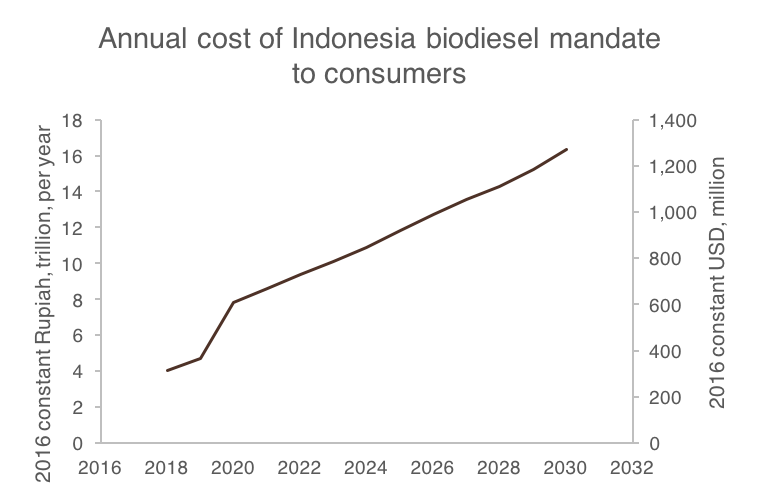Blog
The hidden cost of Indonesia’s biodiesel mandate to consumers
Indonesian drivers probably don’t realize they are paying more at the pump because of their country’s biodiesel mandate, which sets ambitious targets for the blending of biodiesel in diesel fuel. Palm biodiesel is notoriously bad for the climate, since oil palm expansion in Indonesia and Malaysia is strongly linked to deforestation and peat drainage. Indonesians, along with the rest of the world, will pay the price of palm biodiesel’s climate impacts – but they also pay some of the direct financial cost right now. Biodiesel is subsidized by funds generated from the palm oil industry, and when consumers buy fuel blended with subsidized biodiesel, the price per liter remains the same. But that fuel has less energy in it, and so drivers end up having to fill up their tanks more often – and paying more for it – to drive the same distance every year.
Indonesia is serious about promoting biodiesel. The country is a net importer of petroleum and a major exporter of palm oil, and replacing imported petroleum with palm biodiesel is one of its main strategies for achieving energy independence. Indonesia currently requires 20% biodiesel blending (although historically, the country has always missed its biodiesel target by half or more). Biodiesel is typically more expensive than petroleum diesel, and the situation in Indonesia is no exception. Since fuel prices in Indonesia are tightly controlled, the government offsets the higher cost of biodiesel with subsidies, paying out the price difference per liter between biodiesel and petroleum diesel to biodiesel producers. This subsidy is funded by the Palm Oil Estate Fund, which is turn is paid with levies on exports of palm oil and palm products from Indonesia. It is often the same palm oil companies paying the levies as receiving the benefit of the subsidies.
But the subsidy does not actually cover the entire cost premium of biodiesel. Biodiesel has 8-9% less energy per liter than petroleum diesel. What this means in practical terms is that cars running on biodiesel blends travel fewer kilometers per liter, so they have to fill up their tanks more often to travel the same distance as a car running on pure petroleum diesel. Because diesel in Indonesia is so cheap to start with, the added cost of burning through fuel faster isn’t very noticeable – around 100 thousand Rupiah (Rp) or 8 USD per year for a typical car, given the actual biodiesel blend level of around 11% in 2016. But it adds up. In 2016, Indonesian drivers together paid around Rp 1.4 trillion (100 million USD) in added fuel costs.
This cost is only going to increase. Indonesia’s biodiesel mandate is scheduled to increase to 30% in 2020 (although it’s possible this step change will be delayed), and as total transport fuel consumption is expected to grow steadily, this means the total amount of biodiesel required, and the total additional fuel costs to consumers, will ramp up quickly. The figure below illustrates what the total consumer cost of the biodiesel mandate will be each year going forward if the mandate is fully met.
The outcome described here reflects some historical numbers and a couple of reasonable assumptions about the future:
- Average diesel price in 2016 was Rp 5,275
- National biodiesel consumption in 2016 was 3.008 billion liters
- Total diesel consumption in transport in 2016 was 24.9 billion liters
- Exchange rate of 13536 Rp per 1 USD
- Projection of total transport fuel demand taken from BPPT
- 2015 total diesel consumption in transport from USDA
- Assuming the share of diesel blends in total transport fuel remains constant at 2015 levels
- Assuming diesel cost will increase following the crude oil price projection from EIA

